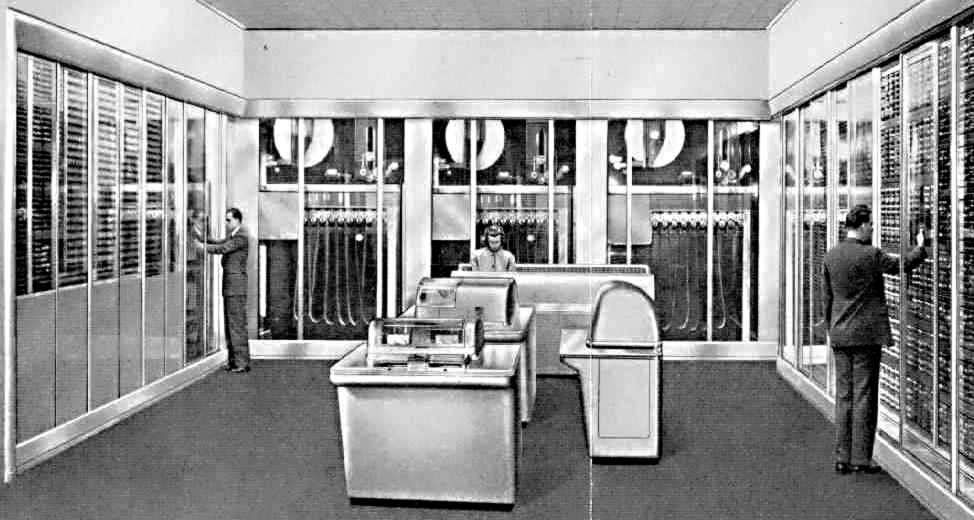| Thomas J Watson Sr, Father of IBM |
Page 2 of 2
Entering the Machine AgeAlthough he had a long held conviction that accounting machinery was the way to conduct business he was shocked to learn that in 1929 only 2% of the nation's accounting needs were being met by machinery. Something needed to be done. Benjamin D Wood was an educational researcher at Columbia University and his problem was marking thousands of test results. Seeing that manual methods were not getting anywhere he begged an appointment with Watson. When they met at Watson's club he told his assistant to make sure that they were interrupted at one o' clock. In the end they talked until 5:30. Wood had a vision of how IBM's mechanical computers could change every aspect of life and Watson listened. Two days later trucks load of tabulators, sorters, card punches and counters were delivered to Columbia University. It was followed by an army of engineers and training people to show Wood's staff how it all worked. Watson visited the laboratory often and was pleased to see it all going smoothly - then one day he sensed that Wood was being too lavish in his praise of the machines. "What's wrong with the machines" asked Watson. Wood answered that there was no need to get angry "I am convinced that these machines can operate almost infinitely faster than they are going now!". "How fast?" asked Watson. Wood answered that as they were electrical the speed of light was the limiting factor. A gleam appeared in Watson's eye and the next day the IBM engineers were carpeted for not spotting this simple fact. Wood was put on the IBM payroll and was the first PhD on the IBM staff. The IBM involvement with Columbia spread. An astronomer, Wallace Eckert, discovered that the machines could be use in lunar calculations. He persuaded Watson to set up the Thomas J Watson Astronomical Computing Bureau. IBM supplied a sequencing mechanism and the only mechanical multiplier available at the time. This was an early precursor of the electro-mechanical computers that would be built in the near future. Drawn to this exciting centre of computer development was a young man called Howard Aiken. In 1936 Aiken began to learn of the successful use of IBM equipment in scientific research. Aiken knew about the modified 601 multipliers and sequencing mechanisms used and he knew that to go further he needed to start from scratch. He started to dream about building a computer. Aiken didn't like Watson's paternalistic and demanding style of doing things but nevertheless he asked IBM for help. Watson eventually financed the experiment with an initial gift of one million dollars which grew to five million dollars as the machine was built. The Mark I, as it was called, is really Aiken's story but it had an important effect on Watson and on IBM. SSEC and ....Aiken's Mark I was unveiled in 1944. Two years later IBM had produced the SSEC - Selective Sequence Electronic Calculator. Watson had ordered them to! The Endicott plant worked 24 hours a day, seven days a week to do it. It had 12,500 valves, 21,400 relays and was way ahead of anything else. It could store eight 20-bit numbers in electronic memory, 150 numbers on the relays and 20,000 numbers on sixty reels of punched tape. It was more powerful than ENIAC - the first true electronic computer which was completed a year earlier. The SSEC was the first publicly available computer and it was used for many years to do work ranging from the design of turbine blades to oil field exploration.
The SSEC Selective Sequence Electronic Calculator The next step for IBM was to build a range of electronic computers. But they didn't. J Presper Eckert and John Mauchly visited IBM looking for help with the building and marketing of their machine but Watson was so sure that IBM was ahead he sent them away. Instead Remington Rand got the prize - the Univac. This looked like the end of IBM in the new world of electronic computing but Rand bungled it. Over and over again they snatched defeat from the jaws of victory and gave IBM the time it need to make up for the slow start. IBM produced the 603 electronic calculating machines in 1946. Over 5000 were manufactured. The first real IBM computer was the 701 in 1952 but it didn't look as good as Sperry Rand's Univac. The IBM machine needed an operator to feed punched cards; the Univac used more modern magnetic tape. This may have been true but many of IBM's customers were already using punched cards and so the 701 was a more evolutionary approach! Twenty 701's were leased at $24,000 per month and IBM was at last a fully fledged computer company. In 1952 Thomas Watson Junior had become president of IBM and new era had begun. Thomas Watson Senior remained chairman of IBM until he died of a heart attack in 1956 at the age of eighty-two. The legacy he left behind had more than enough momentum for the future - but it would be the task of his son to see it through.
To be informed about new articles on I Programmer, sign up for our weekly newsletter, subscribe to the RSS feed and follow us on Twitter, Facebook or Linkedin.
<ASIN:026201310X> <ASIN:0553070118> |
||||||
| Last Updated ( Friday, 16 February 2024 ) |


